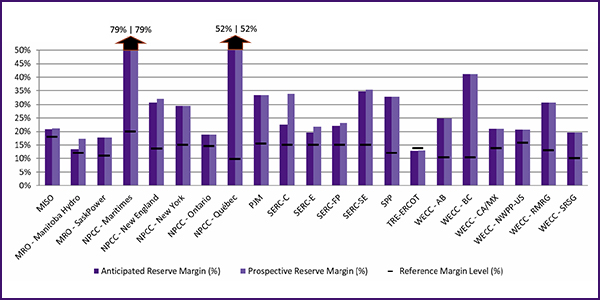Most regions are well prepared for the summer season, though the ongoing COVID-19 pandemic is a significant source of uncertainty, according to NERC’s 2020 Summer Reliability Assessment released Tuesday.
ERCOT Makes up Ground
NERC found that in nearly all areas the anticipated reserve margin for the June-September summer months “meets or surpasses” the reference margin level. The only exception is Texas, where the Electric Reliability Council of Texas is projecting an anticipated reserve margin of 12.9%, above last year’s level of 8.5% but still short of its reference margin of 13.75%.
Texas’ shortfall comes in spite of the region adding nearly 2 GW of new on-peak generation resources since last year, and ERCOT recalculating peak load to incorporate an expected drop in demand related to the pandemic. Echoing FERC’s 2020 Summer Energy Market and Reliability Assessment released last month, NERC warned that “operating mitigations and [Energy Emergency Alerts] may be needed [by ERCOT] to meet extreme demand or extreme resource derated conditions.” (See Emergency Measures Possible for ERCOT, FERC Warns.)
In a media call, NERC’s Mark Olson said that ERCOT was the only independent system operator that had updated its projected reserve margin to reflect the effects of the coronavirus on demand, although other regional organizations have acknowledged significant changes in demand linked to state and municipal shelter-in-place orders. Last month, the Northeast Power Coordinating Council called the drop in demand a useful cushion against other potential COVID-19 impacts including workforce disruptions or interruptions to fuel supply. (See Sagging Demand Cushions NPCC’s Summer Outlook.)
“In general what you’re seeing is a conservative [demand] estimate across the power system, and I would not say that there’s a tighter condition [due to pandemic mitigation],” said Olson, NERC’s senior engineer and manager of reliability assessments.
Long Tail to COVID-19 Impacts
While resource adequacy is not threatened by the pandemic, system operators expect that COVID-19 will continue to impact their operations even as mitigation measures are relaxed by state and local governments. A major concern is that such relaxation could actually lead to “resurgence in virus activity” requiring sequestration of staffers at utilities, as well as among supporting services and supply chains for equipment and fuel.
This threat to staff availability, and mitigation measures to prevent it, has been the topic of considerable discussion, including in NERC’s Pandemic Preparedness and Operational Assessment — Spring 2020 release in April as a “bridge” to the summer assessment. That assessment also warned of elevated risks of cyberattacks and potential issues with distributed energy resources. (See PPE, Testing Top Coronavirus Concerns for NERC.)
The new report moves beyond the immediate threat to look at impacts with a longer horizon. Some of the utilities’ long-term worries are a direct outgrowth of steps put in place earlier this year to protect staff from the outbreak — specifically, delays in maintenance, installation of new generation and retirement of existing facilities that were previously planned for spring.
While NERC acknowledged in the report that these measures were necessary to reduce health risks to essential personnel and may have to be continued for an unknown amount of time, it warned that utilities must be prepared for “higher-than-expected forced outages” during peak demand periods. The organization considers this a likely enough risk that it plans to update its Generator Availability Data System to allow the collection of data on outages with pandemic-related causes for ease of future analysis.
Seasonal Risks Highlighted

The summer assessment also looked at concerns specific to the summer months, such as restrictions on the ability of utilities to provide mutual assistance during the 2020 Atlantic hurricane season, which is expected to be unusually active with up to 19 named storms and six major hurricanes. (See Pandemic Adds to 2020 Hurricane Season Challenges.) NERC urged system operators to refer to the Electric Subsector Coordinating Council’s outage response plan to ensure their strategies are consistent with expert recommendations.
Wildfires are another source of worry for the western U.S. and Canada. While national fire agencies predict normal or below-normal threats of fire in the early summer months, by July large parts of both countries — as well as Mexico — are projected to face above-normal fire risk. Utilities are warned to prepare for widespread outages, both as a result of the fires and preventative measures that could be needed.
“In parts of California … the public safety power shutoff programs are in place, which can help prevent ignitions from the power system,” Olson said. “But in implementing those, it is an issue for the reliability of the power system [that] may need to be taken down when these conditions arise.”





